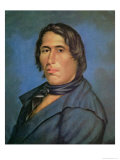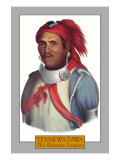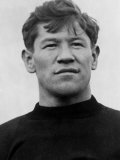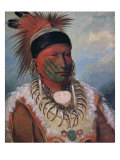|
|
|
|
|
|
|
|
|
|
|
|
BOOKS ABOUT NATIVE AMERICAN CHIEFS
|
|
|
|
|
|
|
|
|
|
|
|
|
|
|
|
|
|
|
|
|
|
 |
|
|
|
|
|
|
Maria Tallchief
b. 1-24-1925, Fairfax, OK
d. 4-11-2013; Chicago, IL
Newsweek magazine once called Maria Tallchief “the finest American-born classic ballerina the twentieth century has produced.” She was the first American ballerina to gain international fame. Her lightning speed and the precision of her dancing captured the world's attention.
Maria was born on Oklahoma's Osage Indian Reservation in 1925 to an Osage father and an Irish-Scottish mother. When she was three, her mother recognized her musical talents and arranged piano and dance lessons for her. As a child, Maria practiced both piano and dance for hours every day. She eventually chose to concentrate on ballet, and by age 15, she was dancing solo roles at the legendary Hollywood Bowl. That was only the beginning. In 1927, she joined the New York City Ballet and was a principal dancer there for many years. She is especially remembered for her role in Igor Stravinsky's “Firebird” in 1949, which established her international reputation. as a Native American, she not only sparked respect for Americans in the ballet world, she also broke through racial barriers in a field dominated by white Europeans.
In 1953, President Dwight Eisenhower presented Ms. Tallchief with the “Woman of the Year Award.” The Osage Tribal Council named her “Wa-Xthe-Thorba” or “Woman of Two Standards” for her achievements in both the Osage world and the world of other cultures. she retired from performing in 1966, but remains active in the arts, serving today as director of ballet for the Lyric Opera of Chicago.
• Dance posters
• Maria Tallchief DVD
|
|
|
|
Tecumseh
b. March 1768; on the Scioto River, near Chillicothe, Ohio
d. 10-5-1813; Ontario, Canada
Tecumseh, a war leader of the Shawnee, rallied various Indian tribes in a mutual defense of their lands, which eventually led to his death in the War of 1812. Cities in the states of Michigan, Kansas, Missouri, Nebraska, Oklahoma, are named after Tecumseh, as well as a city the province of Ontario. The Canadians rank Tecumseh 37th in the Greatest Canadian list.
Civil War general William Tecumseh Sherman said he was given the middle name Tecumseh because “my father . . . had caught a fancy for the great chief of the Shawnees.”
FYI ~ The word chilicothe is from the Shawnee name Chalahgawtha, meaning “principal town”, as it was a major settlement of the tribe.
|
|
|
|
Tenskwatawa was a Shawnee religious leader known as “The Prophet”, the brother of Techumseh. He advocated return to the ancestral lifestyle of the tribes and a large following and confederacy grew around his prophetic teachings.
The 1811 Battle of Tippecanoe, the site of Tenskwatawa's “Prophetstown”, marked a defeat for Techumseh's confederation and a political treasure for future president William Henry Harrison.
|
|
|
|
Jim Thorpe
b. 5-28-1888; Oklahoma
d. 3-28-1953; California
Jim Thorpe won Olympic gold medals in the pentathlon and decathlon, played football in college and professionally, and played professional baseball and basketball. His Olympic medals, which were taken away because he had accepted payment for playing minor league baseball before the 1912 Olympics, were restored in 1983. He died in poverty.
FYI - Thorpe's Sac and Fox traditional name was Wa-Tho-Huk, meaning “path lighted by great flash of lightning” or, “Bright Path”. His Catholic mother raised him in that faith; after she died his father sent him to Haskell Institute in Lawrence, KS and Carlisle Indian Industrial School in Pennsylvania.
|
|
|
|
Uncas
b. c. 1588; near Thames River in present day Connecticut
d. c. 1683
Uncas as a sachem, or first chief, of the Mohegans, allied his tribe with the English colonists against other Native American groups.
FYI - James Fenimore Cooper used the name Uncas for the son of Chingachgook in his novel The Last of the Mohicans: A Narrative of 1757, confusing the names Mohegan and Mohicans.
|
|
|
|
Nancy Ward, Nanyehi
b. 1738; Chota in present day Monroe Co., Tennessee
d. 1822-4
Nanyehi, a Ghigau or Beloved Woman of the Cherokee Nation, is known as Nancy Ward in English. As a Ghigau she sat in councils and made tribal decisions such as sparing the life of a woman white settler who taught Ward to weave on a loom and care for dairy cattle.
|
|
|
|
White Cloud, Chief of the Iowas
This portrait of White Cloud, head chief of the Iowa nation, probably was painted in London while the chief was touring with Catlin's Indian Gallery, 1844/45. [National Gallery of Art]
• State of Iowa posters
|
|
|
|
|
|
previous page | top
List Notable Native Americans > a | b | c | d-e-f-g | h-i-j | k-l | m | n-o-p-q | r | s | T-Z
|
|
I have searched the web for visual, text, and manipulative curriculum support materials - teaching posters, art prints, maps, charts, calendars, books and educational toys featuring famous people, places and events - to help teachers optimize their valuable time and budget.
Browsing the subject areas at NetPosterWorks.com is a learning experience where educators can plan context rich environments while comparing prices, special discounts, framing options and shipping from educational resources.
Thank you for starting your search for inspirational, motivational, and educational posters and learning materials at NetPosterWorks.com. If you need help please contact us.
|
|
|
|























